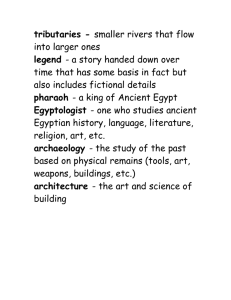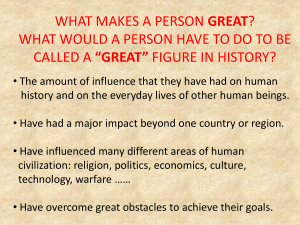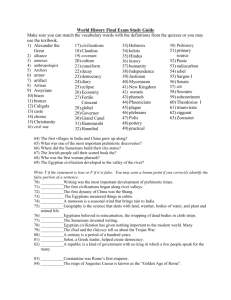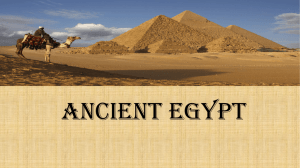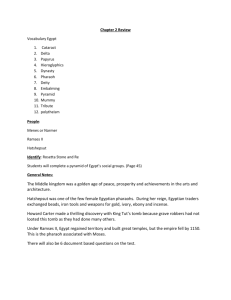What you see, stylistic characteristics and function
advertisement
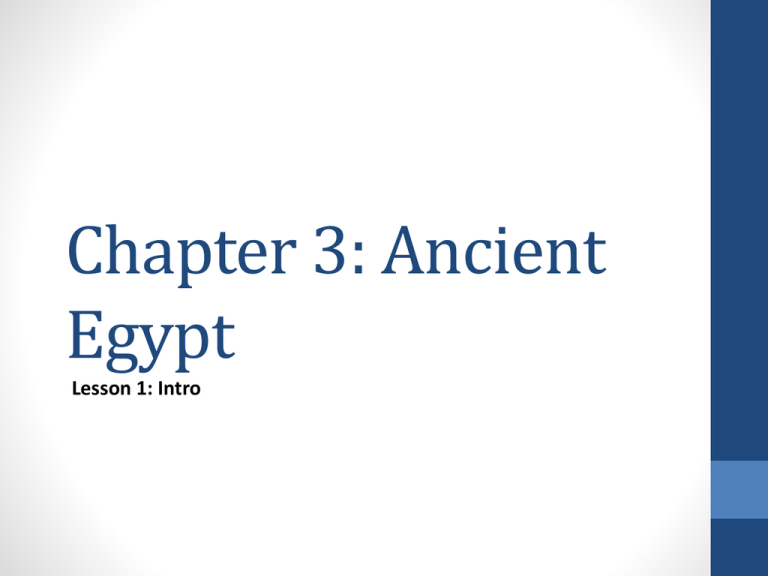
Chapter 3: Ancient Egypt Lesson 1: Intro Warm-up 9-18-14 Ch.3 Egypt Obj: SWBAT apply knowledge of Ancient Egyptian art to respond to short answer questions with 80% accuracy HW: Due Tomorrow (Fri 9-19): Complete Exit slip Make context card for EGYPT Respond to the following: 1. What is the function of this work? 2. What does this represent about the spiritual/religious beliefs of the people? 3. What is the size of the work? 4. What meaning could that show us? Academic Language Glossary Never use: • “stuff” “Thing/thingy” Instead: • Aspects, object(s) • “it” • Sculpture, painting, piece of architecture • The figure, the Egyptian people, pharaoh/king • Large/thin • “they,” “he/she,” “him/her” • Fat/skinny Class Expectations 1. Students are respectful of everyone and all belongings 2. Students are prepared and on time with all materials 3. Students follow directions the first time given 4. Students keep food and drinks away during class (water only) 5. Students keep personal electronics off and out of sight (explicit permission will be given to use electronics). • • • Hoods off Food Away Backpacks, purses, bags, etc. on back of chair or under desk Announcements: Read intro to chapter 4: Aegean Art Bring your brown book to exchange for an cream colored book. Agenda: Warm-up Announcements and Reminders Creating context card Writing your short answer responses Office Hours Tuesday 3:00-4:00 Thursday 3:00-4:00 Book exchange Context Card--Egypt 14. This image shows the likeness of a Pharaoh. Describe how this work represents the spiritual and cultural beliefs of the Egyptian people. Include references to the stylistic characteristics. Use a minimum of 3 examples to explain. Make sure you make direct connections to the imagery found in this work of art. (Questions to think about: why are these figures so static and rigid? What are they wearing? What about the clothing is important? Why are the figures in this pose?) Writing your short answer response • Take out yesterdays handout • Switch handouts with someone and have them read your paragraph. While reading annotate • Check mark—agree/correct • X (Cross out) ---rewrite better word/phrase • ?=unclear/not sure if this is correct How to write your short answer response Visual Evidence (What you see, Spiritual/Cultural meaning stylistic characteristics and function) 1. Headdress, fake beard and kilt 1. Shows the figure’s status as a pharaoh Evidence #1 The male figure wears a traditional headdress, fake beard and kilt which shows that the figure is a Pharaoh How to write your short answer response Visual Evidence (What you see, Spiritual/Cultural meaning stylistic characteristics and function) 3. Function: to House the Ka (eternal life source) in a tomb 3. Shows Egyptian belief in the eternal life source and the importance of life after death. Importance of funerary rituals Evidence #3 The function of the work was to house the Ka in the pharaoh’s tomb. This shows the Egyptian belief in the eternal life source, the existence of the afterlife and the great importance of funerary traditions. How to write your short answer response Visual Evidence (What you see, Spiritual/Cultural meaning stylistic characteristics and function) 2. Stiff, static pose 2. Show a serious representation of the figure, shows great respect for the figure Evidence #2 The work uses shows the pharaoh in a stiff and static pose. This style shows that the pharaoh is highly respected and taken seriously. How to write your short answer response Visual Evidence (What you see, Spiritual/Cultural meaning stylistic characteristics and function) 3. Canon of proportions (idealized portrait) 3. Shows the divinity of the pharaoh—the belief that the Pharaoh was god-like Evidence #2 The work uses the canon of proportions to create an idealized portrait of the pharaoh. This shows the belief that the pharaoh was considered god-like and must be portrayed without flaws to be fully respected. Writing Practice AP Test Essay Prompt: The images show a plan and a view of the pyramid complex at Giza. Using specific evidence, analyze how the pyramid complex was shaped by both the beliefs and the practices of the culture that built it. (10 minutes) What is it asking?: The images show a plan and a view of the pyramid complex at Giza. Using specific evidence, to explain both the beliefs and the practices (spiritual/ritual) of the culture that built it. (10 minutes)
